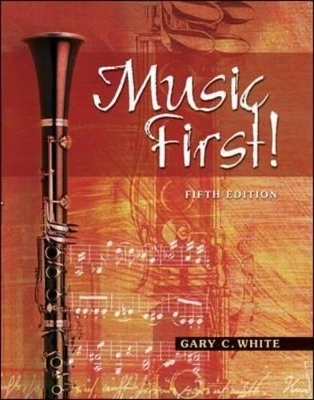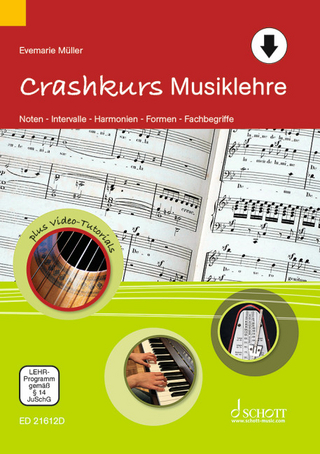
MP Music First!
McGraw Hill Higher Education
978-0-07-327500-0 (ISBN)
- Titel erscheint in neuer Auflage
- Artikel merken
Based on tested methods used by the author during many years of teaching, "Music First!" takes a step-by-step approach to the fundamentals of music theory and basic composition, engaging students by a combination of explanation and interaction. Students learn cumulatively as they progress through the book. This popular "learn-by-doing" approach reinforces theoretical principles through practice and enlivens any Fundamentals course.
Gary White holds a Ph.D. in Music Composition from Michigan State University. At his retirement in 1994 he was Distinguished Professor of Music at Iowa State University, where he developed and administered the music theory curriculum and established the electronic and computer music studio. For a number of years he was also in charge of music listening courses for the general student at Iowa State. Dr. White is the composer of over fifty published musical compositions and the author of Music First! (a music fundamentals textbook) and Instrumental Arranging (a textbook for orchestration and arranging), both published by McGraw-Hill. He has been awarded the U.C. Berkeley Medal by the University of California at Berkeley, was named a National Arts Associate by Sigma Alpha Iota, and has held a MacDowell Colony Fellowship. His compositions have won many prizes and awards, including the Toon van Balkom Prize and the Shenandoah/Percussion Plus Prize.
White, Music First! 5e Contents Chapter 1 Elements of Music: Pitch Middle C The Octave Quick Check Musical Notation The Staff The Treble Clef The Bass Clef Ledger Lines The Grand Staff Playing Melodies on a Keyboard Instrument Quick Check Drawing Musical Symbols Treble Clef Bass Clef Note Heads Key Terms Listening Using What You Have Learned Assignments Chapter 2 Elements of Music: Rhythm The Beat Simple Division of the Beat Rhythm Patterns Repeat Sign Quick Check Drawing Quarter Notes and Eighth Notes Note Heads Stems Improving Your Ear Ear-Training Exercise I Ear-Training Exercise II Ear-Training Exercise III Longer Note Values Quick Check Rests Quick Check The Tie The Dot Quick Check Compound Division of the Beat Quick Check Dotted Rests Quick Check Summary of Relative Note and Rest Values Key Terms Listening Using What You Have Learned Assignments Interlude I Chapter 3 Simple Meter Accent Meter Bar Line Measure Meter Signature Simple Meter Quick Check 2/2 Meter Quick Check The Upbeat Quick Check Subdivision of the Beat Quick Check The Dotted Eighth Note Quick Check Triplets Key Terms Listening Using What You Have Learned Assignments Chapter 4 Compound Meter Duple-Compound Meter Quick Check Triple-Compound Meter Quick Check Quadruple-Compound Meter Quick Check Beaming in Simple and Compound Meters Key Terms Listening Using What You Have Learned Assignments Interlude II Chapter 5 The Keyboard The Half Step The Whole Step The Sharp Sign The Flat Sign The Natural Sign Enharmonic Equivalents Writing Sharps, Flats, and Naturals Writing Half Steps and Whole Steps The Key Signature Quick Check The Double Sharp The Double Flat Quick Check Key Terms Listening Using What You Have Learned Assignments Chapter 6 Major Scales/Major Keys Major Scales The Tonic Half Steps and Whole Steps in the Major Scale Diatonic Scales Other Major Scales Key Signatures for Major Scales The Circle of Fifths Determining the Key from a Key Signature The Dominant Solfeggio Quick Check Key Terms Listening Using What You Have Learned Assignments Interlude III Chapter 7 Intervals Intervals and Scale Degrees Quick Check Specific Qualities of Intervals Perfect Intervals Major Intervals Minor Intervals Quick Check Writing Intervals Below a Given Note Quick Check The Augmented Fourth and Diminished Fifth Summary of Common Intervals Other Intervals Key Terms Listening Using What You Have Learned Assignments Chapter 8 Minor Scales/Minor Keys The Natural Minor Scale The Harmonic Minor Scale The Melodic Minor Scale Key Signatures for Minor Scales Relative Major and Minor Scales Tonic (Parallel) Major and Minor Scales The Dominant in Minor Solfeggio and Numbers Quick Check Transposition Quick Check Key Terms Listening Using What You Have Learned Assignments Interlude IV Chapter 9 Chords--Looking at the Musical Background Harmony Chord Triad Popular Music Chord Symbols Diminished and Augmented Triads Simple and Expanded Positions of Triads Inversion of Triads Block Chords versus Arpeggiation of Chords Seventh Chords The Major-Minor Seventh Chord The Minor Seventh Chord Key Terms Listening Using What You Have Learned Assignments Chapter 10 The Harmonic System The Harmonic System in Major Keys Roman Numeral Analysis Primary Chords Secondary Chords The Harmonic System in Minor Keys Circle Progressions The Harmonic Background of Rounds Part Songs Key Terms Listening Using What You Have Learned Interlude V Chapter 11 Introduction to Harmonizing and Composing Harmonizing Melodies Nonharmonic Tones Harmonic Rhythm Playing Accompaniments on a Keyboard Adding Rhythm to Accompaniments Phrases in Music Melodic Contour of Phrases Harmonic Cadence Form A Final Word Using What You Have Learned Appendix 1 Inversion of Intervals Appendix 2 Popular Music Chord Symbols Appendix 3 Guitar Chords Appendix 4 Playing a Keyboard Instrument Appendix 5 Answers to Selected Problems in the Assignments Songbook Glossary Index
| Erscheint lt. Verlag | 1.6.2006 |
|---|---|
| Verlagsort | London |
| Sprache | englisch |
| Maße | 203 x 254 mm |
| Gewicht | 843 g |
| Themenwelt | Kunst / Musik / Theater ► Musik ► Musiktheorie / Musiklehre |
| ISBN-10 | 0-07-327500-X / 007327500X |
| ISBN-13 | 978-0-07-327500-0 / 9780073275000 |
| Zustand | Neuware |
| Informationen gemäß Produktsicherheitsverordnung (GPSR) | |
| Haben Sie eine Frage zum Produkt? |
aus dem Bereich



